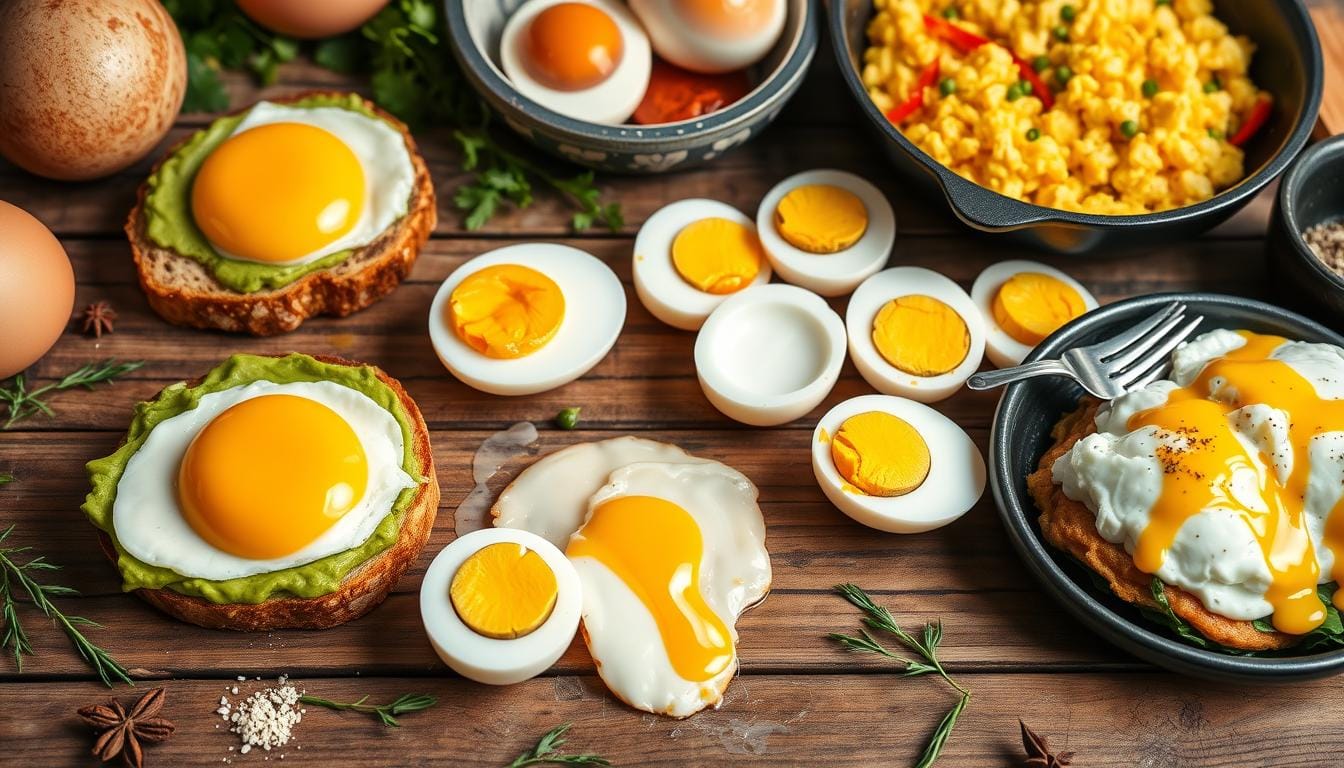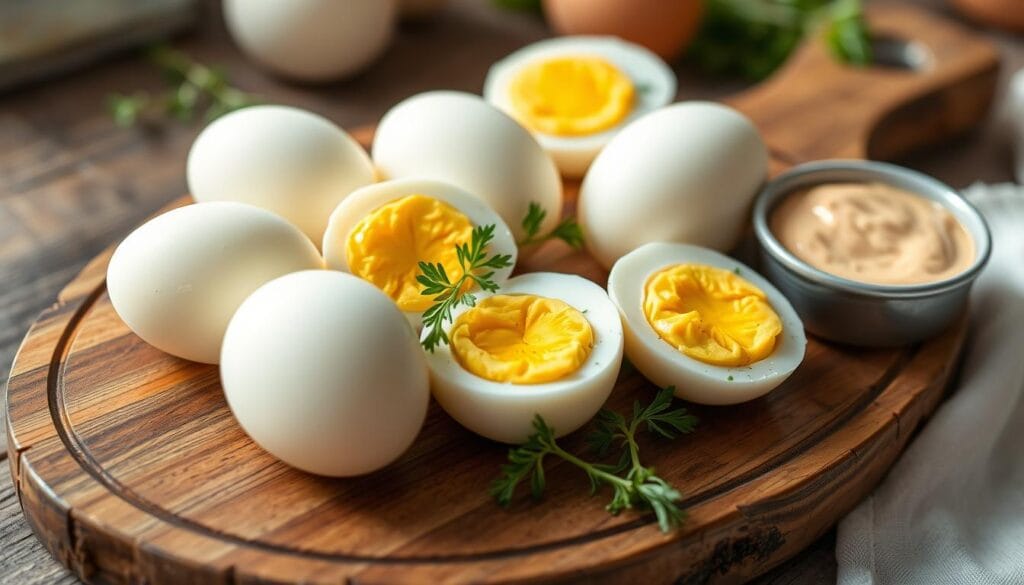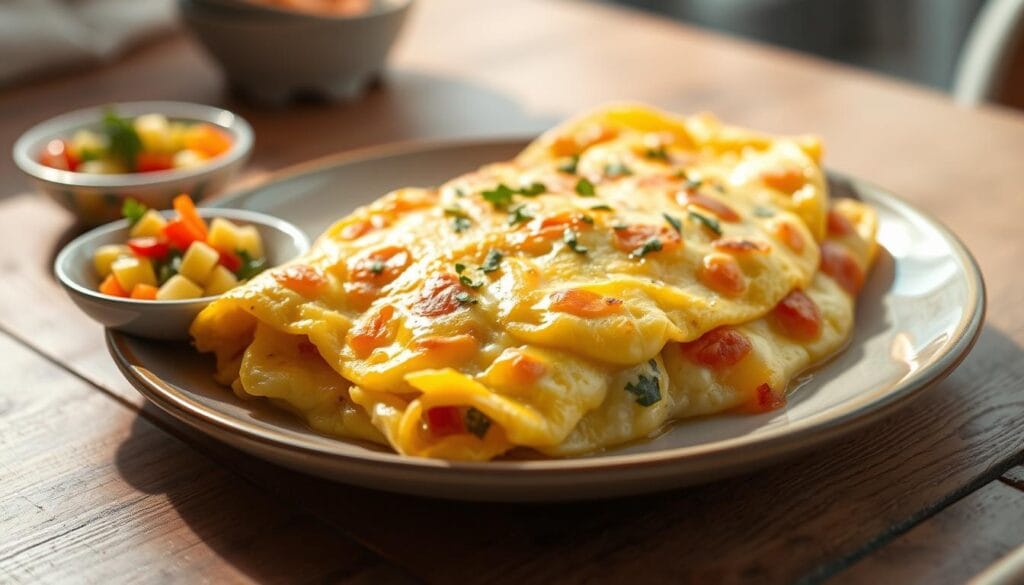As a busy parent, I often felt stuck in a breakfast loop. But then, I started trying new egg cooking methods. It completely changed my breakfast game. This guide will teach you six simple ways to cook eggs perfectly, whether you’re a pro or just starting.
Eggs are not just good for breakfast; they’re great for many meals. You can make soft-boiled eggs or crispy fried ones. This article will cover hard-boiling, scrambling, poaching, and baking eggs. You’ll learn how to make your eggs better and impress everyone.
Let’s explore egg cooking together. Every bite is a new adventure, and every meal a celebration of eggs.
Understanding Different Types of Eggs
Eggs come in many varieties, each with its own taste, size, and nutritional value. Knowing what makes each type special can help you pick the best egg for your dishes. This knowledge is key to mastering the art of cooking eggs.
Chicken Eggs
Chicken eggs are the most common and versatile. They come in sizes from small to jumbo. They’re great for making omelets or boiled as a quick snack.
Quail Eggs
Quail eggs are smaller and more delicate than chicken eggs. They have a rich, intense flavor. Their small size makes them perfect for hors d’oeuvres or as a unique garnish.
Duck Eggs
Duck eggs are larger and richer in flavor than chicken eggs. They have a higher fat content, making them creamy and rich. Their deep yellow yolk adds a vibrant color to dishes.
Exploring the world of eggs can elevate your cooking. From the classic chicken egg to the gourmet quail and decadent duck, there’s a world of flavors to discover. Each type offers something special for your culinary adventures.
Essential Tools for Cooking Eggs
Preparing delicious eggs needs the right tools. From cookware to special utensils, the right gear makes a big difference. Let’s look at the key tools for cooking eggs.
Cookware Options
A good non-stick frying pan or saucepan is key for egg cooking. The GreenPan Paris 8-Inch Ceramic Non-Stick Fry Pan is great for even heat and easy cleaning. For boiling, the All-Clad D5 3-Quart Stainless-Steel Saucepan is a solid choice.
Utensils Needed
- The Lamson Chef’s Fish Spatula is perfect for flipping eggs gently.
- The OXO Better Balloon Whisk is a must for fluffy scrambled eggs.
- The Cuisinart Stainless-Steel Slotted Spoon helps remove poached eggs carefully.
Recommended Accessories
- The Egg-Perfect Egg Timer ensures perfect boiled eggs every time.
- Egg poaching cups from Amazon help make professional-looking poached eggs.
- The OXO Good Grips 8-Inch Fine Mesh Strainer is great for rinsing and separating eggs.
Investing in the right kitchen gadgets, egg cooking equipment, and non-stick pans helps master egg cooking. With the right tools, you can create a world of tasty and perfectly cooked eggs.
Soft Boiled Eggs: The Creamy Delight
Soft-boiled eggs are a tasty breakfast or snack. They have a set white and a runny yolk that flows out when you eat them. Getting the cooking time just right is key to making them perfect.
Choosing the Right Cooking Time
The best cooking time for soft-boiled eggs is 5 to 6 minutes. This depends on the egg size and how runny you like the yolk. Large hen eggs work best for this.
Use the boil or simmer method for 5-6 minutes. For cold water, cold eggs, it’s about 3.5 minutes. Remember, induction cooktops might need an extra 30 seconds to a minute.
Techniques for Peeling
Peeling soft-boiled eggs can be tricky, but it’s doable with the right method. Use eggs that are at least a week old. This makes peeling easier.
Gently tap the egg on a hard surface to crack the shell. Then, peel it under cold running water. This way, the shell comes off smoothly, leaving you with a perfect egg.
Serving Suggestions
Soft-boiled eggs are very versatile. You can enjoy them in egg cups with toast for dipping. Or, add them to salads, grain bowls, or soups for extra creaminess and protein.
They can be stored in the fridge for up to 3-4 days. This makes them a great choice for quick snacks or meal prep.
| Cooking Method | Cooking Time |
|---|---|
| Boil or Simmer | 5-6 minutes |
| Cold Water, Cold Eggs | 3.5 minutes |
| Induction Cooktop | 5.5-7 minutes |
Hard Boiled Eggs: The Perfect Snack
Hard-boiled eggs are a great snack that can be eaten alone or used in dishes like egg salad and deviled eggs. They are easy to make perfectly every time with just a few steps.
Cooking Time Guidelines
To make hard-boiled eggs, cook them for 10-12 minutes. This ensures the whites and yolks are fully set. For a runnier yolk, cook for 8-10 minutes.
Cooling and Peeling Tips
- After cooking, put the eggs in an ice bath. This stops the cooking and makes peeling easier.
- Older eggs peel better. Fresh eggs can be harder to peel.
- Peel the eggs under cold water for a smoother peel.
Hard-boiled eggs are perfect for meal prep. They can be stored in the fridge for up to 5 days without peeling. They’re a great source of protein and can be enjoyed on their own or used to make egg salad or deviled eggs.
“Hard-boiled eggs are a healthy, versatile snack that can be enjoyed in a variety of ways. With these simple cooking and peeling tips, you can have perfectly cooked eggs every time.”
Scrambled Eggs: Fluffy and Flavorful
Scrambled eggs are a beloved breakfast dish that’s quick and easy to make. They can be creamy, fluffy, or anything in between. Learning how to make them can make your mornings better. Let’s look at how to make creamy scrambled eggs and some great add-ins for the perfect taste.
Basic Scrambled Eggs Recipe
To start, you’ll need:
- 2 large eggs
- 2 Tablespoons of salted butter
- Salt and pepper to taste
Whisk the eggs with a bit of salt and pepper. Melt butter in a pan over low heat. Then, add the eggs and stir gently. This helps make soft, creamy eggs. Cook until they’re still a bit moist.
Add-Ins for Extra Flavor
Here are some ways to make your scrambled eggs even better:
- ¼ cup of shredded cheddar cheese for a cheesy delight
- 1/2 Tablespoon of heavy cream, sour cream, or cream cheese for extra creaminess
- Chopped herbs like chives, parsley, or dill for a fresh, herbal note
- Sautéed vegetables like onions, bell peppers, or mushrooms for a veggie-packed breakfast
Tips for Perfect Texture
Here are some tips for the perfect scrambled eggs:
- Pre-salt the eggs before cooking to help them retain moisture and tenderness.
- Adjust the amount of liquid, such as milk or cream, to control the firmness and creaminess of the eggs.
- Experiment with cooking methods and techniques, such as gentle stirring or leaving the eggs slightly wet, to achieve your desired texture.
- Carefully time the incorporation of any add-ins to ensure they complement the eggs without compromising the overall result.
With these tips, you can make the perfect creamy scrambled eggs for your breakfast. Try different seasonings and add-ins to create your own special scrambled egg dish.
Fried Eggs: Sunny-Side Up or Over Easy?
Fried eggs come in two popular styles: sunny-side up and over easy. Each style has its own taste and texture. Whether you’re making a quick breakfast or a fancy brunch, learning to fry eggs is key.
Cooking Techniques for Different Styles
To make a sunny-side up egg, cook it without flipping. Crack the egg into a hot skillet with oil. Let the whites set while the yolk stays runny. For over easy eggs, flip them quickly to cook the top a bit. This makes the yolk slightly firmer but still yummy.
Seasoning Suggestions
Fried eggs can be seasoned in many ways. Salt and black pepper are classic. You can also add fresh herbs like chives or parsley. For something bolder, try paprika, cayenne, or hot sauce to enhance the egg yolk doneness.
Pairing Ideas
Fried eggs are great with many foods. Try them on buttery toast for a simple egg cooking methods breakfast. Or add them to bacon, avocado, or roasted veggies for a bigger meal. They’re also good on burgers, in grain bowls, and even on pizza, adding a tasty runny yolk.
“The perfect fried egg should have a crisp, lacy edge and a warm, runny yolk that oozes with every bite.”
Poached Eggs: A Brunch Favorite
Poached eggs add a silky texture and a runny yolk to any brunch. Learning to poach eggs can boost your cooking skills and wow your guests. We’ll explore how to poach eggs perfectly, avoid common errors, and find tasty ways to serve them.
Getting the Perfect Poached Egg
To poach eggs well, start by heating water gently. Adding vinegar to the water helps the egg whites set and keep their shape. Crack the egg into a small cup, then slide it into the water slowly. This method helps the egg white form a neat, round shape around the yolk. Cook the egg for 3-4 minutes for a runny yolk and firm white.
Common Mistakes to Avoid
- Using old eggs: Fresh eggs will hold their shape better during the poaching process.
- Boiling the water: Rapid boiling can cause the egg to break apart. Aim for a gentle simmer instead.
- Overcrowding the pot: Poaching multiple eggs at once can disrupt the water flow and lead to misshapen results.
Delicious Serving Ideas
Poached eggs are great for many dishes. Serve them on toasted English muffins for classic eggs Benedict, or with avocado and paprika for a healthy brunch. You can also add them to salads, grain bowls, or on roasted veggies for a protein-packed meal.
Learning to poach eggs is a key skill for brunch. By using these tips, you’ll make eggs that impress everyone. Enjoy this tasty breakfast or brunch favorite!
Omelets: Versatile and Delicious
Omelets are a breakfast favorite that can be made in many ways. You can choose from a simple cheese omelet or one filled with veggies. With just a few ingredients and some technique, you can make a tasty omelet to start your day.
Classic Omelet Recipe
To make a basic omelet, start by whisking 2-3 eggs in a bowl. Add a bit of salt and pepper. Then, melt butter in a non-stick pan over medium heat and pour in the eggs.
As the eggs start to set, use a spatula to push the edges towards the middle. This lets the uncooked egg flow to the edges. Once it’s almost set, add your fillings, like mozzarella cheese, and fold it in half.
Creative Filling Ideas
- Spinach, mushrooms, and feta cheese
- Diced ham, bell peppers, and onions
- Bacon, cheddar cheese, and chives
- Avocado, tomato, and fresh basil
Cooking Tips for Success
- Use a non-stick pan to make flipping the omelet easier.
- Cook the eggs over medium heat, lowering the temperature if they start to brown too quickly.
- Prepare your fillings ahead of time, as omelets cook quickly.
- Beat the eggs until they’re light and frothy for a fluffy texture.
- Avoid using black pepper in the egg mixture, as it can discolor the omelet.
- Fold the omelet gently to maintain its delicate structure.
With these tips, you’ll soon be making tasty cheese omelets and breakfast ideas with ease. Try different egg folding techniques and fillings to make your own unique omelets.
Baking Eggs: A Unique Approach
Baking eggs is a fun and easy way to cook, perfect for meal prep. Egg muffins are a favorite, where eggs are mixed with various ingredients and baked in a muffin tin. This method results in a creamy, cheesy dish that you can customize.
Techniques for Baking Eggs
To bake eggs in ramekins, crack an egg into a buttered ramekin. Add a bit of cream or half and half, and season with salt, pepper, and herbs or spices. Bake for 10 to 15 minutes, depending on your yolk preference.
Serving and Enjoying Baked Eggs
Baked eggs are great for breakfast or brunch. Serve them with toast, a salad, or other breakfast items like sweet potato hash browns. They’re also good with crepes, French toast, or pancakes. Plus, you can make them ahead of time and reheat them for a quick, protein-rich meal.
FAQ
What are the different methods for cooking eggs?
The article talks about several ways to cook eggs. These include hard-boiled, soft-boiled, scrambled, fried, poached, and baked eggs.
What are the characteristics of different types of eggs?
The article explores the differences in chicken, quail, and duck eggs. It looks at their flavors, sizes, and nutritional values.
What essential tools are needed for cooking eggs?
You’ll need non-stick pans, saucepans, and ramekins for cooking eggs. Whisks, spatulas, and slotted spoons are useful. Egg timers, poaching cups, and egg separators can also help.
How do you cook soft-boiled eggs?
Soft-boiled eggs cook for 4-6 minutes. The time depends on egg size and desired texture. To peel, tap the egg gently and remove the shell under cold water.
What is the process for hard-boiling eggs?
Hard-boiled eggs cook for 10-12 minutes. Then, they’re cooled in an ice bath to stop cooking. This prevents green rings. For easier peeling, use older eggs and peel under cold water.
How do you make scrambled eggs?
Whisk eggs with salt and pepper. Cook in a non-stick pan over medium-low heat, stirring constantly. Adding milk or cream makes them creamy.
What are the different styles of fried eggs?
There are sunny-side up, over easy, and over hard fried eggs. Sunny-side up eggs cook without flipping. Over easy and over hard eggs are flipped to cook the yolk.
How do you poach an egg?
Create a whirlpool in simmering water with vinegar. Slide in the egg. Cook for 3-4 minutes for a set white and runny yolk.
What are the keys to making a successful omelet?
Whisk eggs with salt and pepper. Pour into a heated, buttered pan. Cook until set. Add fillings like cheese or vegetables before folding. Cook over medium heat and avoid overfilling.
How can you bake eggs?
You can make egg muffins or baked eggs in ramekins. For muffins, whisk eggs with add-ins and bake. For ramekins, crack an egg into a buttered ramekin with cream and seasonings, then bake until set.



